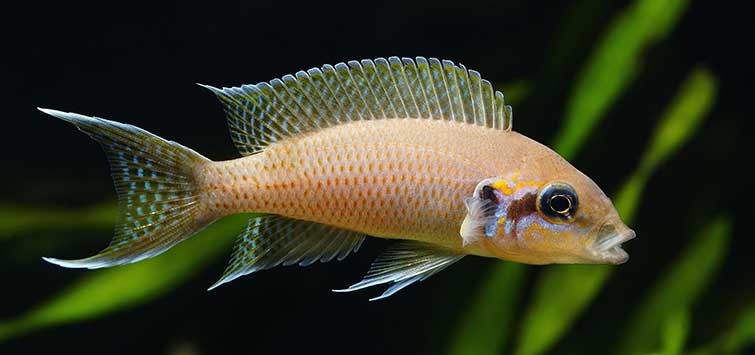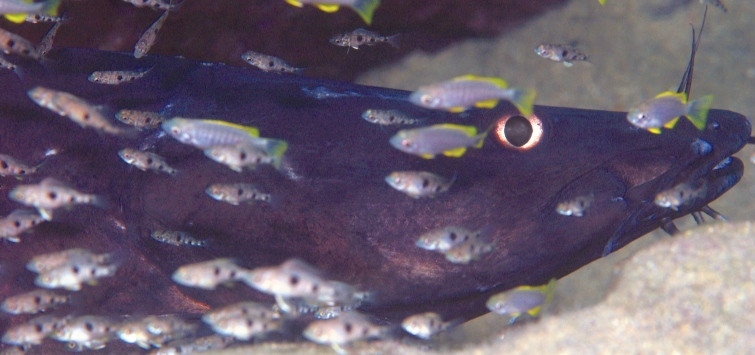Planted Aquascaping for African Rift Lake Cichlids
The African Rift Lakes are some of the largest lakes in the world, and they encompass a vast range of ecosystems. There are, however, some consistencies across the diverse areas inhabited by African Rift Lake cichlids. These tend to be an absence of aquatic plants (many African cichlids graze on the common algae patches and the microorganisms living among them), a water chemistry with a high pH and very high mineral hardness, and cichlid habitats composed of rocky and sandy areas.
This creates several restrictions for aquascaping and planting. Any plants will need to survive these fishes’ often boisterous activity, be suited to the water chemistry, and find a home in a tank with rock-and-sand substrate. In this article, we will explore the plants, hardscape, and layout styles that can work for an African Rift Lake cichlid aquarium.
African Rift Lake Cichlids
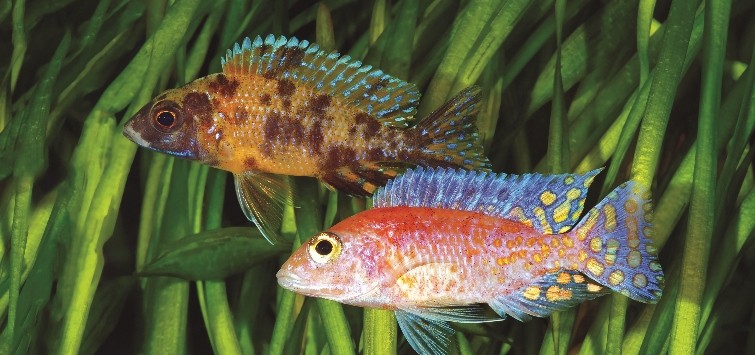
Cichlids from the African Rift Lakes have different preferences for the rocky and open sandy areas found there, conditions that we tend to imitate in our tanks for them. Rocky areas can include large outcrops, clusters of boulders, and piles of smaller stones, while sandy areas can be next to one of these features or appear in pockets among them. Though these areas do not usually feature plants, that doesn’t mean you can’t use them to add some greenery and warmth. You just have to approach it with both the water chemistry needs and behavior of the fish in mind, and get creative.
All Rift Lakes are alkaline, with high pH and very hard water. Accordingly, all plants must be able to tolerate these conditions. Salt-tolerant plants must be chosen. Fish behavior is also a major factor. African Rift Lake cichlids are large, fast, and boisterous, and they often chase mates and rivals aggressively. So while aquariums for these fish are commonly kept overstocked to mitigate aggression, the activity of so many fish will eventually knock over or destroy any delicate plants in the area.
There is also breeding and spawning behavior to consider. A courting male may choose a place to display or a mated pair may choose an area to spawn and then redecorate it by clearing the space, digging out a cave, and pushing things around until they are happy. If a spawn is successful, the male or couple may actively defend it from the rest of the community, further knocking around any plants in the vicinity. For those lower in the pecking order, they will often have a favorite crevice or rock to dive into or behind when threatened by the more aggressive fish, and again, any plants in this area are likely to be torn apart. On top of this, most cichlids from the Rift Lakes are omnivorous, and many relish munching on soft vegetation. This is a collective nightmare for a planted tank hobbyist. But where there is a will, there is a way!
Plants in the Rift Lake Aquarium
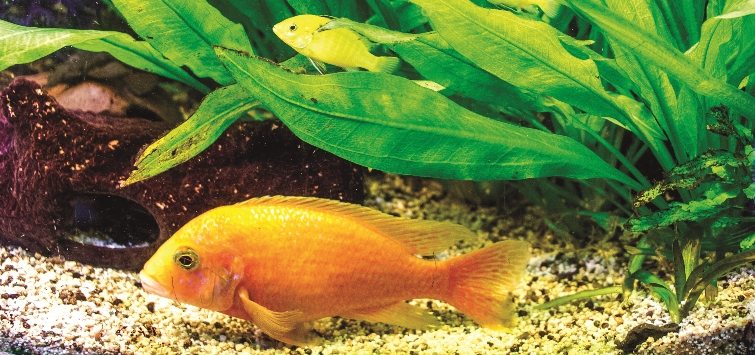
Any plant for a Rift Lake aquarium must first be capable of growing in high-pH, hard water. There are numerous plants that will adapt, but not all will survive the rough treatment the fish will dole out. It is important to consider the characteristics of the plants and their positioning to give them a better chance of surviving.
To counter the rough activity of African cichlids, two approaches seem to work. You can choose either hard and leathery plants that stand up to the battering or soft plants that will part easily when fish dive through them. Hard-leaved plants, such as Anubias spp., Java fern (Microsorum pteropus and its variants), and Bolbitis heudelotii, are often left alone by the fish and are epiphytic, so they can be tucked among rock crevices or tied to hardscape. This will also prevent harm caused by substrate diggers.
Mosses such as Java moss (Vesicularia dubyana) are also epiphytic and look great grown on rocks, though some fishes may eat this plant. It is worth trying, though, as it is quite tolerant of water conditions. If your fish are likely to leave softer leaves alone, you can try salt-tolerant floating plants, such as hornwort (Ceratophyllum demersum) and duckweed (Lemna minor), which are great for reducing nitrates and will happily part as fish dash though them. Duckweed is more likely to be eaten by some species, but it can often reproduce faster than it is consumed, and it can also be grown in a pond or other non-cichlid tank and added to top up your supply from time to time.
Rooted plants suitable for Rift Lake conditions that are also likely to either be tough enough to withstand fish activity include Vallisneria americana “gigantea,” Cryptocoryne spp., including C. affinis, C. aponogetifolia, C. crispatula var. balansae, C. wendtii, C. beckettii, C. walkeri, C. undulata, and feature plants such as Amazon swords (Echinodorus spp.) and onion plants (Crinum spp.) including C. natans and C. calamistratum) make excellent focal points.
A mass stand of giant vals can look great along the back and sides of an aquarium, framing the layout and giving height as the tops inevitably trail along the surface. A stand of crypts creeping along the foreground among stones can also look stunning and balance green in other levels. The roots of all of these plants are quite strong once established and will usually hold well as fish breeze through their foliage. However, it can be a challenge to secure these rooted plants so that they don’t get knocked away or dug out before becoming established, so some creative aquascaping for your planted cichlid tank is needed here.
As plants commonly grow in mulm-filled areas near sunken hardscape, it will look natural and be practical in gravel with large or heavy boulders or rock slabs stacked around the base to secure them. If the plant is likely to spread on runners, such as val or crypts, leaving an area of boulders with cracks for potential runners to come up safely is also a good idea. A single specimen of Amazon sword or onion plant can be secured by surrounding it with a ring of rockwork.
If using a crushed coral or aragonite base, which is recommended to keep the water full of minerals and buffered, sometimes a separate container with normal pea gravel, filter wool, or another material is a better option for healthy roots, and the planting container can be concealed by stones or hardscape. You can also keep the pots above the coral sand and camouflage with boulders. Experiment to see what holds down your plants best and which will work with your Rift Lake community and layout.
Note that both crypts and crinums can suffer after being moved to a new location or put in different water conditions. Should the leaf browning and disintegration that is often called “melt” occur, remove the affected leaves and be patient, as most will sprout again soon. Plants such as crypts, crinums, val, and swords will all benefit from root supplementation until sufficient mulm collects around the roots, so it is a good idea to add a fertilizer tab or ball to the root zone to get things going. As Rift Lake aquariums tend to be heavily stocked and high in minerals, I have found that fertilizers are usually not needed, though some additional iron supplementation may be useful from time to time.
Hardscape
Rift Lake hardscaping can often just look like a mess of rocks and boulders, and indeed this is needed to create a good number of territories, breeding sites, and escape routes for chased fish. However, careful planning is needed to make your planted cichlid tank attractive while also avoiding disaster.One of the fundamental needs before starting is a safe base for resting a large quantity of stone. This can either be a deep bed of gravel, buried egg crate, or, ideally, both. Egg crate is a sheet of sturdy crosshatched plastic commonly used in industrial lighting that has become a material of choice for stacking large rock piles in an aquarium. It can be cut to the size of the aquarium base with gardening shears or simply broken to size with pliers and buried under the gravel before placing stone.
The advantage of this is that it spreads out the weight of the stones, so if a rock happens to get knocked over, the bottom of the tank glass will usually be protected from the impact. This, of course, does not protect the sides of the tank, so avoid resting any rocks against them and keep space around the tank glass just in case things shift. Having a moderately deep gravel base will help to secure stones in place.
You should be very confident about the security of your rock stacking, as you can never guess what the diggers will do, so use large, sturdy rocks buried in your base that should be impossible for fish to move or unsettle, and make sure any stacked on top are well nested in crevices and won’t be knocked over or fall out should anything shift. Flat slabs of basalt or slate are useful for stacking this way or straight on top of each other, as long as pieces become smaller as you go and nothing will slide.
I’ve seen slate stacked like a Jenga game in the past, and, like the game, the removal of one piece can bring the whole thing down! You can secure stones together with an appropriate bonding agent, but I always say that it’s better to be safe than sorry should a bond ever fail.
A different approach with basalt or slate can be to position slabs vertically (secured by surrounding stones) and lean a few other slabs against it. This adds height, drama, depth, and a lot of cracks for fish to hide in, and you will likely need to use less rock to achieve the look.
For the rounder boulders, nesting small stones above large stones in large crevices works well, but to be safe, you can always just place large stones at the rear and smaller sizes toward the front for depth, all safely on the gravel. Be sure to keep a lot of crevices and caves available as you go, and more is always better, as some fish are picky about their homes.
For adding height and warmth (and less weight), wood is an underused material for African Rift Lake cichlids, and it can be used to warm up a cool granite or dark basalt stonescape, or matched with warmer colored river rock to great effect. It is also less dangerous if it falls, so resting some choice branch wood on top of a stone stack or sticking up and out of it not only looks good but is safer than going for a full stone wall.
Driftwood can easily add height in some areas, which not only looks attractive but also blocks lines of sight between aggressive fish and helps to demarcate territories. When rearranging the rocks would be a massive headache, just adding an extra branch (or five) can often quickly help fix aggression issues in a tank. You might even forego rocks altogether and just build a pile of driftwood tangles for your cichlids. Some red volcanic rock can blend in with this well, and wood almost always looks great with plants or moss affixed to it, so it can be very useful for creating an attractive look in the planted cichlid tank.
Open space is always important in an aquascape, especially if your fish are sand dwellers or dig out open pits for mating displays, so keep some at the front or off to the side for balance. For aesthetics, following a right angle or U-shaped layout is always a good way to start, and you can create a unique look from there.
A Planted Rift Lake Habitat
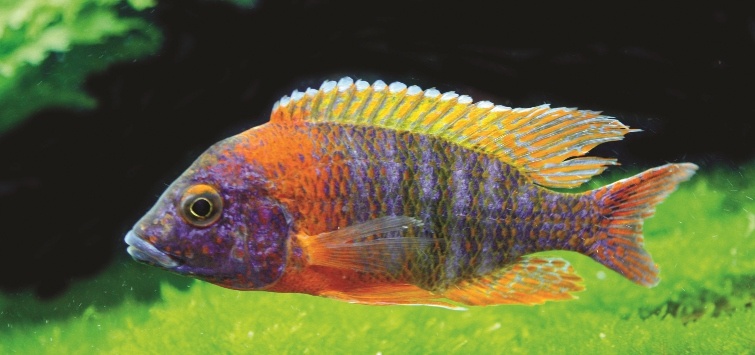

.png?h=595&iar=0&w=2781&hash=5FD5E69473BCC22199FBFA2FB71B6033)


